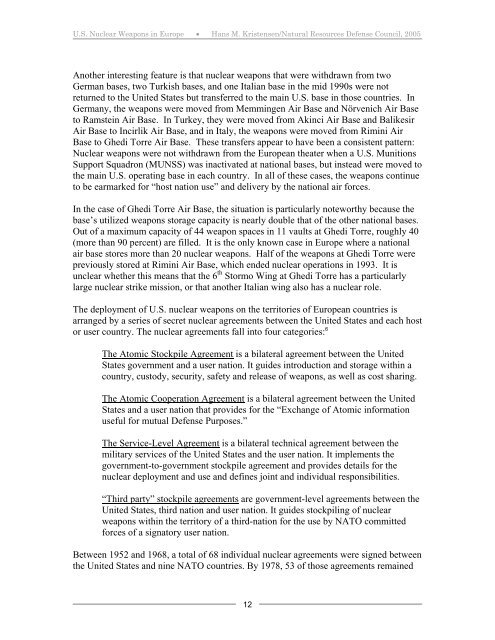US Nuclear Weapons in Europe - Natural Resources Defense Council
US Nuclear Weapons in Europe - Natural Resources Defense Council
US Nuclear Weapons in Europe - Natural Resources Defense Council
You also want an ePaper? Increase the reach of your titles
YUMPU automatically turns print PDFs into web optimized ePapers that Google loves.
U.S. <strong>Nuclear</strong> <strong>Weapons</strong> <strong>in</strong> <strong>Europe</strong> • Hans M. Kristensen/<strong>Natural</strong> <strong>Resources</strong> <strong>Defense</strong> <strong>Council</strong>, 2005<br />
Another <strong>in</strong>terest<strong>in</strong>g feature is that nuclear weapons that were withdrawn from two<br />
German bases, two Turkish bases, and one Italian base <strong>in</strong> the mid 1990s were not<br />
returned to the United States but transferred to the ma<strong>in</strong> U.S. base <strong>in</strong> those countries. In<br />
Germany, the weapons were moved from Memm<strong>in</strong>gen Air Base and Nörvenich Air Base<br />
to Ramste<strong>in</strong> Air Base. In Turkey, they were moved from Ak<strong>in</strong>ci Air Base and Balikesir<br />
Air Base to Incirlik Air Base, and <strong>in</strong> Italy, the weapons were moved from Rim<strong>in</strong>i Air<br />
Base to Ghedi Torre Air Base. These transfers appear to have been a consistent pattern:<br />
<strong>Nuclear</strong> weapons were not withdrawn from the <strong>Europe</strong>an theater when a U.S. Munitions<br />
Support Squadron (MUNSS) was <strong>in</strong>activated at national bases, but <strong>in</strong>stead were moved to<br />
the ma<strong>in</strong> U.S. operat<strong>in</strong>g base <strong>in</strong> each country. In all of these cases, the weapons cont<strong>in</strong>ue<br />
to be earmarked for “host nation use” and delivery by the national air forces.<br />
In the case of Ghedi Torre Air Base, the situation is particularly noteworthy because the<br />
base’s utilized weapons storage capacity is nearly double that of the other national bases.<br />
Out of a maximum capacity of 44 weapon spaces <strong>in</strong> 11 vaults at Ghedi Torre, roughly 40<br />
(more than 90 percent) are filled. It is the only known case <strong>in</strong> <strong>Europe</strong> where a national<br />
air base stores more than 20 nuclear weapons. Half of the weapons at Ghedi Torre were<br />
previously stored at Rim<strong>in</strong>i Air Base, which ended nuclear operations <strong>in</strong> 1993. It is<br />
unclear whether this means that the 6 th Stormo W<strong>in</strong>g at Ghedi Torre has a particularly<br />
large nuclear strike mission, or that another Italian w<strong>in</strong>g also has a nuclear role.<br />
The deployment of U.S. nuclear weapons on the territories of <strong>Europe</strong>an countries is<br />
arranged by a series of secret nuclear agreements between the United States and each host<br />
or user country. The nuclear agreements fall <strong>in</strong>to four categories: 6<br />
The Atomic Stockpile Agreement is a bilateral agreement between the United<br />
States government and a user nation. It guides <strong>in</strong>troduction and storage with<strong>in</strong> a<br />
country, custody, security, safety and release of weapons, as well as cost shar<strong>in</strong>g.<br />
The Atomic Cooperation Agreement is a bilateral agreement between the United<br />
States and a user nation that provides for the “Exchange of Atomic <strong>in</strong>formation<br />
useful for mutual <strong>Defense</strong> Purposes.”<br />
The Service-Level Agreement is a bilateral technical agreement between the<br />
military services of the United States and the user nation. It implements the<br />
government-to-government stockpile agreement and provides details for the<br />
nuclear deployment and use and def<strong>in</strong>es jo<strong>in</strong>t and <strong>in</strong>dividual responsibilities.<br />
“Third party” stockpile agreements are government-level agreements between the<br />
United States, third nation and user nation. It guides stockpil<strong>in</strong>g of nuclear<br />
weapons with<strong>in</strong> the territory of a third-nation for the use by NATO committed<br />
forces of a signatory user nation.<br />
Between 1952 and 1968, a total of 68 <strong>in</strong>dividual nuclear agreements were signed between<br />
the United States and n<strong>in</strong>e NATO countries. By 1978, 53 of those agreements rema<strong>in</strong>ed<br />
12
















